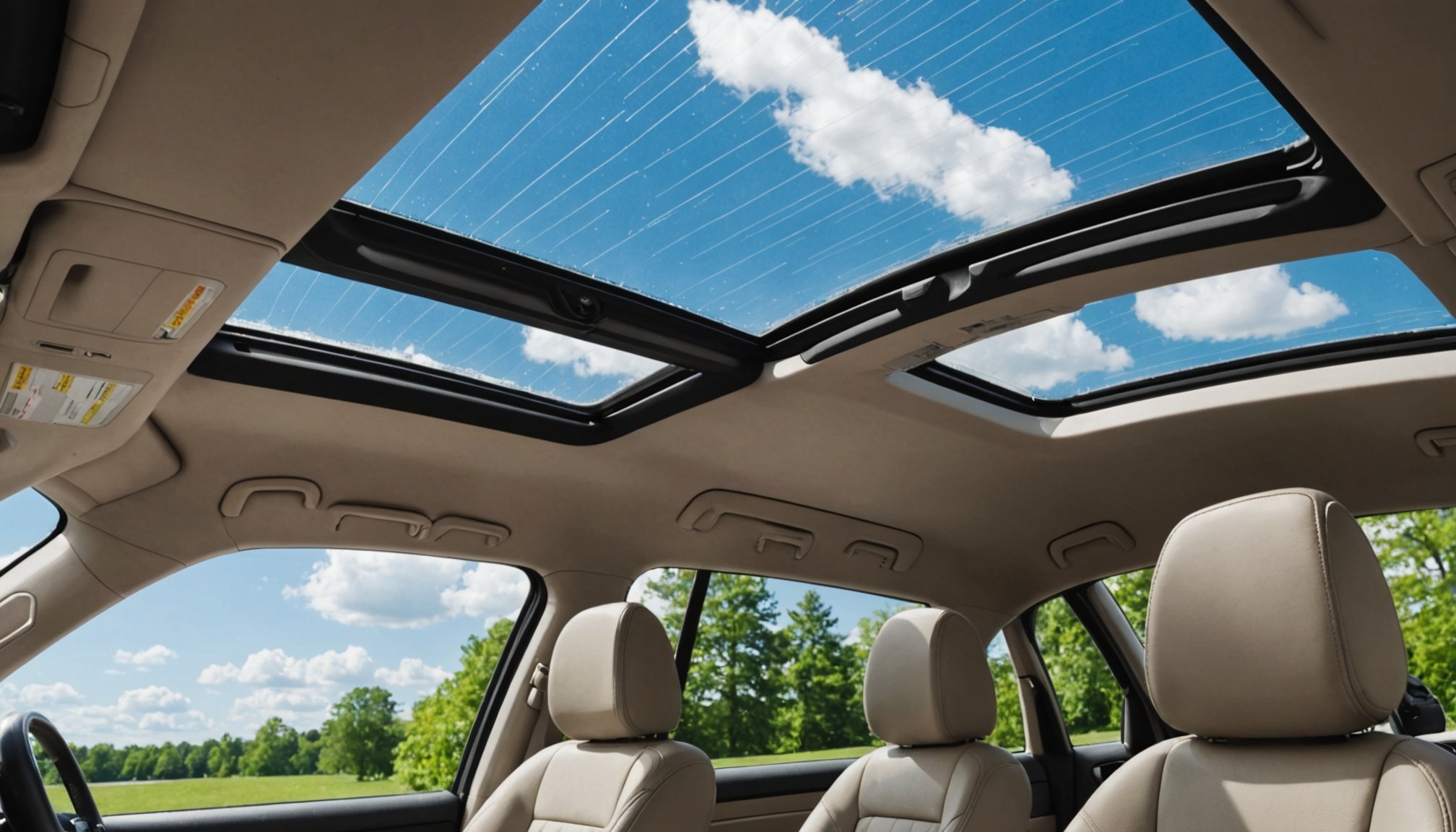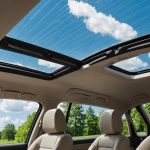Quick maintenance checklist to prevent sunroof leaks
Regular sunroof maintenance is crucial for effective leak prevention. Start with a thorough visual and manual inspection of the sunroof seals and weatherstripping. Look for cracks, gaps, or hardened rubber that could compromise the seal. Damaged seals allow water to seep into your vehicle, undermining rainproofing car interiors.
Next, clear the sunroof drains meticulously. Blocked drains lead to water buildup, which increases the risk of leaks. Use compressed air or a flexible wire to ensure the drains are unobstructed. This step is fundamental in maintaining dry interiors and preserving your car’s structural integrity.
Also read : Top strategies to safeguard your car’s roof antenna on off-road excursions
Finally, lubricate all moving parts of the sunroof regularly. Proper lubrication ensures smooth operation and keeps seals pliable, preventing premature wear. Use silicone-based lubricants recommended specifically for automotive rubber parts to avoid degradation.
Following these essential tips for sunroof care not only extends the lifespan of the sunroof mechanism but also protects your vehicle from costly water damage. Consistent upkeep means better rainproofing car interiors and a more enjoyable driving experience, rain or shine.
Have you seen this : Top tips for maintaining the safety and dependability of your car’s electronic parking brake
Preventative measures to keep water out
Preventing water intrusion starts with sunroof weatherproofing. Applying a high-quality sealant around the sunroof edges can effectively stop sunroof leaks. Ensure the sealant is compatible with your vehicle’s materials to maintain durability. Regularly inspect these seals for wear and tear, as degraded seals are the primary cause of water seepage.
Parking strategies also play a crucial role in water prevention. When expecting heavy rain, parking your car on a slight incline—preferably with the front elevated—helps water drain away from the sunroof and reduces pooling risks. This simple technique enhances natural rain protection for cars, reducing pressure on seals.
For enhanced defense, consider installing rain guards or rain protectors specifically designed for sunroofs. These accessories direct water flow away from the sunroof panel, further minimizing leak risks. Selecting quality rain guards suited to your vehicle model can make a substantial difference in overall water prevention.
Combining stop sunroof leaks efforts through sealant application, strategic parking, and rain guards creates a multilayered approach. This synergy ensures your car’s interior stays dry even in heavy downpours, maintaining comfort and protecting your vehicle’s electronics from moisture damage.
Cleaning and caring for sunroof components
Maintaining your sunroof involves regular attention to both the glass and the mechanical parts. To clean sunroof drains effectively, regularly flush them with water to prevent blockages that can cause leaks. Using mild, non-abrasive cleaners on the sunroof glass and frame protects the finish while removing dirt. Avoid harsh chemicals, which can degrade the seals and damage paint.
Debris often accumulates in the tracks and seals, impairing smooth operation. Carefully removing leaves or dirt with a soft brush or compressed air keeps the tracks clear. This also prevents damage to the drainage system and helps maintain proper car interior waterproofing.
Routine care of rubber seals is crucial for sunroof longevity. Clean seals gently using a damp cloth and condition them with a silicone-based lubricant to keep them flexible and prevent cracking. Establishing a sunroof care guideline involves inspecting and cleaning these parts monthly. This will ensure consistent protection against water intrusion and promote optimal functionality.
Following these sunroof cleaning steps diligently extends the lifespan of the entire system, maintaining both performance and aesthetic appeal. Consistent upkeep will save costly repairs and enhance daily driving comfort.
Inspection tips for common sunroof issues
When inspecting sunroofs for leaks, start by examining the seals closely. Early warning signs of seal damage include cracked, brittle, or missing rubber. These issues often lead to sunroof water ingress, which causes interior damage and unpleasant odors. Pay special attention to drainage channels; if clogged, water can pool, increasing the risk of leaks.
To detect sunroof problems effectively, inspect the metal frame around the sunroof for any rust or corrosion. These can weaken the structure and interfere with the sunroof’s operation. If the mechanism feels stiff or stuck, lubricate moving parts and check for debris that may block smooth movement.
A practical way to diagnose sunroof water ingress is to perform a controlled water test. Use a gentle hose spray around the closed sunroof to reveal leaks immediately. Look inside the cabin for damp spots or water stains during this test. This method helps pinpoint exact leak locations before more severe damage occurs.
By following these steps when inspecting your sunroof for leaks, you can catch problems early and prevent costly repairs related to drainage or sealing failures.
Troubleshooting and DIY fixes for sunroof leaks
When you notice a sunroof leak, a DIY sunroof repair can be an effective first step. For temporary fixes, using waterproof tape or applying a silicone-based sealant around the edges can help contain leaks until a permanent solution is possible. These emergency fixes are handy but should not replace a thorough repair.
To properly fix a sunroof leak, inspect the sunroof’s seal and gasket. If you detect cracks or wear, replacing the gasket is often necessary to restore a watertight barrier. Using the correct type of sealant can also enhance waterproofing car roof surfaces around the sunroof frame.
However, if the leak persists after gasket replacement or if water appears inside the vehicle in multiple areas, it’s prudent to seek professional help. Complex issues like clogged drainage tubes or misaligned sunroof panels require specialized tools and expertise. DIY sunroof repair is useful for minor leaks, but relying on trained technicians ensures the problem is fully resolved, preventing further damage and costly repairs later.
Recommended products and maintenance tools
Maintaining a sunroof effectively requires using the best sunroof maintenance products tailored to its specific needs. A dedicated sunroof cleaning kit usually contains gentle cleaners that safely remove dirt and debris without damaging seals or glass. These kits often include microfiber cloths and brushes designed for reaching tight spots, ensuring comprehensive cleaning.
Clogged sunroof drains are a common issue, and clearing them demands specialized tools for sunroof care such as flexible drain-cleaning wires. These wires help to dislodge debris blocking the drainage channels, preventing water buildup and leaks. Regular drain clearing with such tools minimizes water damage risks.
For preserving the integrity of the sunroof’s rubber seals, applying quality seal conditioners is essential. Brands renowned for their seal conditioners and protectants include products enriched with silicone or foam-based formulations that keep seals supple and resistant to cracking. Using these conditioners regularly extends the lifespan of seals and prevents leaks by maintaining flexibility.
By choosing the right combination of cleaning products, lubricants, and specialized tools, sunroof maintenance becomes manageable and effective, promoting smooth operation and protecting against common issues like leaks and stuck mechanisms.



